The Physics Of Forces In Aikido:
Making The Weak Equal To The Strong
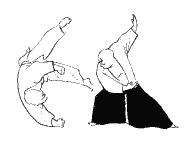
By Jearl Walker
Editor’s Note: This is the second in
a series of articles on the physics of force. The first article was “The
Physics Of Forces In Judo.” This article will similarly explore
some of the basic physics of forces, rotation and torques in aikido.
Like Judo, Aikido is a martial art that demands an intuitive understanding
of the physics of forces, torques, stability and rotational motion. This
article examines a few of the basic aikido techniques. The grace that
each requires is not easily conveyed, but each technique can be broken
into components that can be examined in terms of classical physics. The
experiments I shall describe call for actual performance of the technique,
but you should do them only under expert supervision since aikido if performed
incorrectly can be dangerous to you and your opponent.
Aikido is similar to judo in that it seeks to overcome the opponent’s
stability. Aikido, however, is a relatively modern form of martial art
that incorporates techniques from a number of other martial arts. It is
distinguished by its firm code of avoiding injury to the opponent. Hence
it is a form of self-defense rather than a sport like judo. It involves
no techniques that can be regarded as attacks. I think it is the most
difficult of all the martial arts to learn. Its demands for skill, grace
and timing rival those of classical ballet.
Aikido employs many of the same principles of physics that
are found in Judo. Suppose your opponent grasps you by the wrists from
behind. In one aikido maneuver you smoothly lower your body while bringing
your wrists upward and over your head toward the front.
Your opponent hangs on to your wrists but is brought forward by your
descent and slight lean forward. His position is therefore unstable because
his center of mass is now slightly forward of his feet.
You draw your right leg backward and drop onto your right knee. Your
arms and torso are brought forward and downward in a large arc. Because
the first part of the motion induced your opponent to hold tightly to
your wrists, he is now thrown over your body in a front somersault.
As in much of aikido, your opponent actually throws himself. He cannot
prevent your forward motion because of the unstable posture in which you
initially place him. Even if he has superior body weight, he cannot stop
the motion by pulling downward on your raised wrists. In such a position
he can pull only along the length of your arms. The torque due to such
a pull is zero because there is no “lever” (described in Part
I in this series, “The Physics Of Forces In Judo: Making The Weak
Equal To The Strong”).
Remember, the lever is the perpendicular from the pivot point (in this
case your shoulder) to the line through the force. The line through the
opponent’s pull passes through your shoulder and therefore has no
lever arm. Even if he is heavy or strong, he cannot rotate your arms once
you have them properly over your head.
Many of the techniques in aikido employ the deflection of a force directed
at you. Suppose your attacker throws a punch at your face. To stop the
punch directly requires a large impact force which could cause injury.
A wiser technique is to deflect the strike. Although a large force is
necessary to stop the punch directly, only a small force is needed to
deflect it.
Although most followers of Western style fighting consider an attack
to be an advantage, in aikido the attacker is at a distinct disadvantage
because of the momentum of this strike. You can use his momentum to throw
him to the mat.
Suppose the attacker steps forward with his right foot and slashes at
your face with the side of his right hand (a typical attack in Western
styles of fighting and in karate). You slide your left foot to the rear
as you parry his slash with your left arm. The parry is meant to deflect
the slash, not to stop it or even to slow it, since either effect would
require strength from you. During the parry you guide your attacker’s
right arm downward into the grasp of your right hand. While still not
fighting the forward momentum of his slash, you pull him around in the
circular motion you have begun with the withdrawal of your left foot.
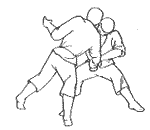 |
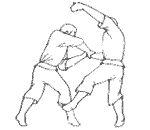 |
The opponent was relatively stable against a pull directly forward because
of his extended right foot, but is highly unstable against a pull forward
and to his left. In such a direction his center of mass does not have
to be moved far before he becomes unstable against a fall. Therefore as
you continue to circle you pull him in that direction. He now has two
serious disadvantages. First, he is committed to a forward motion that
would take a considerable force to stop, even from himself. Second, your
pull and his motion are removing his center of mass from his base of support.
To complete the throw rotate your attacker’s right arm downward
while stepping to your left rear. Turn his wrist upside down and bend
his hand around it. At this point it is impossible for him to prevent
the throw. He is now off balance and completely unable to stop his own
motion. He also cannot pull out of your grip because you have bent his
arm at the wrist. Although his arms may be strong, he cannot prevent the
torque you create when you push his hand around his own wrist. You bring
him to the mat.
How would a strike to the head be handled in karate? In the Korean style
of karate known as “tae kwon do,” I was taught to parry a
slash with a powerful strike across the opponent’s arm. Deflection
was important but so was countering the slash with a large force. Force
was working against force, and usually the stronger person won (I was
rarely that person).
In contrast, circular motion is employed in aikido both for deflection
and to aid in throwing an opponent off balance. Suppose someone approaches
you from behind, reaches around your body and pins your arms to your sides.
You should reach upward and hold his hands tightly to your chest while
sliding your foot forward.
The timing is critical because you want to move your torso forward at
a rate matching the speed of your opponent. If you delay, you will lose
the advantage of exploiting his momentum. If you move too fast, you will
have to drag him forward. You must slide your right foot forward at the
correct speed and then suddenly lean forward and rotate your body to the
right.
The combination of your opponent’s momentum and your rapid rotation
throws him off balance to the right. He cannot prevent your throw because
your lean forward brings his center of mass forward of his feet. He cannot
release himself from the forward motion because of his established momentum,
because you have pinned his hands and because of his grip around your
arms. The centrifugal force on him during your rapid rotation is too large
for him to deal with in this unstable position. Hence he essentially throws
himself to the floor.
Two more examples of how aikido employs a small force to bring an attacker
off balance entail stick fighting (called a jo) that is taught to more
advanced students. Suppose an attacker thrusts a long stick at your midsection,
advancing with his left leg during the lunge and thrusting the stick horizontally,
holding it with the palms of both hands down. It would be futile to try
to stop the end of the stick. You rapidly step forward with your right
foot so that the stick passes you on your left. (The agility to do this
comes only with long practice.) As the stick passes you, turn your body
to face it so that you can grab it with both hands. Your left hand is
forward of your attacker’s outermost hand. Your right hand is between
his hands.
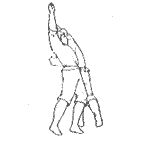 |
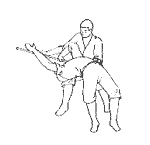 |
In grabbing the stick your objective is not to stop its motion, which
would require considerable force. Rather it is to deflect the lunge upward,
around to your left in a circular motion and then up and over your attacker’s
head. Once he has committed himself to the forward lunge he can do little
to prevent the deflection. He would need a large force to stop his momentum,
and he cannot thrust horizontally at your midsection while pulling downward
to prevent your deflection.
Once you have the stick over your attacker’s head he is easily
thrown. With his left foot forward he is highly unstable against a pull
to his left rear because in that direction his center of mass must move
only a short distance before it is no longer over his support area. When
you have the stick over his head, you pull it downward over his back in
that direction. He falls to the mat on his back and probably releases
the stick.
Suppose you have a stick and a determined attacker rushes forward to
grab its forward end. Allow him to grasp it, but lead him with it (as
if it were a carrot in front of a donkey) so that he continues his rush.
Also lower your end of the stick (the end he is grabbing) to trick him
into bending downward.
Once he has committed himself to this awkward motion and is about to
pass to your right side you bring your end of the stick upward over his
face and then back downward over his back. If this motion is executed
rapidly, he still has a strong grip on the stick and therefore is bent
backward by your pull downward over his back and by the continued forward
motion of his torso. The torque due to his own weight rotates him to the
floor around the pivot point of his feet. His grip on the stick also provides
a torque that rotates him. He actually throws himself to the mat because
of his initial forward thrust and a bit of trickery on your part.
Aikido has hundreds of techniques for employing such trickery against
a determined opponent. In nearly all of them a small deflection of force
parries an opponent’s thrust and then guides it so that he throws
himself down. When I watch an aikido master defend himself, the motion
seems fluid and effortless, and I am inclined to suspect the opponent
of faking when he falls to the floor. The fall is not faked. It looks
that way because the master has spent years developing an intuitive feeling
for the basic physics of forces, rotation and torques.
Acknowledgements:
This article has been edited for clarity. This article
and the previous one in this series, “The Application Of The Physics
Of Forces in Judo,” originally appeared the Scientific American
in the July 1980 issue under to column, “The Amateur Scientist.”
It is reproduced with the consent of Scientific American and the author,
Jearl Walker. We would also like to thank Michael Goodman for the many
illustrations, that also appeared in the original article, as well as
Oscar Ratti for his contribution of the first illustration in this article.
Article © 2002 Jearl Walker
Artwork © 2002 Michael Goodman
About the Author:
Jearl Walker studied tae-kwon-do in high school but had to give it up
to survive college. After earning a PhD in physics, he began to use karate
in his physics classes at Cleveland State University, where he is a professor.
He published on the physics of karate strikes in 1975 in the American
Journal of Physics. The article reprinted here was one of his monthly
"Amateur Scientist" articles from his 13 years of writing for
Scientific American. It is reprinted with permission.
|